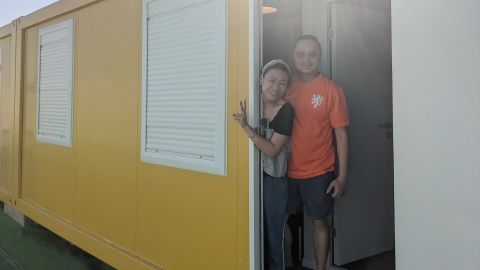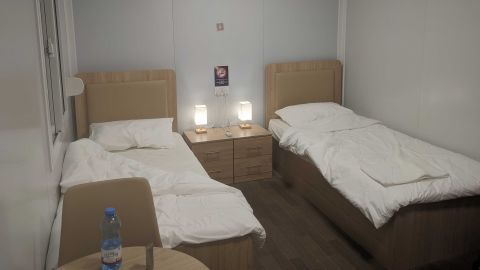Doha, Qatar
CNN
—
As fans trickle into Qatar, they’re understandably in holiday mode as they look forward to the prospect of a desert World Cup.
But where best to stay in a country that is geographically on a peninsula smaller than Connecticut and is the smallest World Cup host in history?
The scramble for accommodation is likely to hot up given Qatar is set to welcome an estimated 1.5 million fans over the month-long tournament, which begins on November 20.
Jimmy and Kennis Leung were among the very first fans to arrive at the Fan Village Cabins Free Zone, one of the largest sites available to supporters, checking in on Thursday.
“They’ve built this in a desert,” Jimmy told CNN Sport, as he scanned his accommodation space, which he was impressed by.
“It is too expensive to stay in a hotel or AirBnB in Doha so this was a great option.”
The Free Zone fan village is around 20 minutes by metro from downtown Doha but at the moment it’s a bit like entering a dystopian world.
There is precious little else around the village – one or two building sites and a main road – so staff quickly direct you to the reception, which is a 10-minute walk across a vast car park.
There is an endless lines of portacabins, organized into different colors and mapped in alphabetical order, stretching into the distance, with large gazebos containing hundreds of empty tables and chairs.
Basketball courts, outdoor gyms and a huge television screen are dotted around the complex where fans can play and relax.
When CNN visited on Friday, only a handful of fans were milling around, though many more were are expected over the course of the tournament.

Navigation is also proving a bit problematic – the Leungs admit to getting lost in the seemingly endless makeshift roads that connect the village. There are, though, electric scooters to get around and staff will even drive you to your door in a golf buggy.
The Leungs work in the media and have traveled from Hong Kong to watch their favorite team, the Netherlands, at Qatar 2022.
“It’s very quiet at the moment but there are food options and the rooms are nice, but a bit small,” Kennis adds.
As fans like the Leungs grapple with finding their feet in Qatar on Friday, they were greeted by the news that soccer’s world governing body FIFA had performed a U-turn and that no alcohol will be sold at the eight stadiums which will host the tournament’s 64 matches.
For those supporters on a budget and are unable to afford what’s on offer from hotels, eight fan villages provide “casual camping and cabin-style” options.
Some World Cup visitors, however, were less impressed with what was on offer.
“There are so many cabins and containers and there’s a big screen that we can all watch the games together but the accommodation, well … What can I say?” Fei Peng from China, who is here to watch over 30 World Cup games, told CNN Sport.
“This is the best option that we can afford. Its so expensive in Doha so we cant expect more.”
One night in the Free Zone fan village cabin starts at $207 a night, according to the Qatar World Cup’s Official Accommodation Agency, but cheaper options can be found at Caravan City, at $114 a night.
And if your heart is set on camping under the stars, a tent in the Al Khor village is available for $423 a night.
If you’re not on a budget, a self-described “eco farm” hut will provide a more luxurious option at $1,023 a night, while a stay on a cruise ship will set you back at least $179.

Many fans are expected stay in neighboring countries to Qatar, flying in and out of the Gulf state for matches.
Qatar Airways announced in May that it had partnered with regional carriers to launch 160 extra daily return flights at “competitive prices” that will shuttle fans from Dubai, Jeddah, Kuwait, Muscat and Riyadh.
There will be no baggage check-in facilities to speed up the transfers and dedicated transportation services will be made available to get fans from the airport to stadiums.
It will also be possible to drive from cities like Riyadh, Dubai and Abu Dhabi, all of which are under seven hours away.
INTERACTIVE: For Lionel Messi and Cristiano Ronaldo, a final shot at World Cup glory
Those coming to Doha will have to contend with the heat.
The tournament was moved to the winter months because of scorching summer temperatures – the average high in Doha in the second half of November is around 28 degrees Celsius (82 degrees Fahrenheit), which is much better than in July, when the World Cup would normally conclude, when the average high temperature is about 42 degrees Celsius (106 degrees Fahrenheit).
Even in winter the heat is energy sapping if you come from a colder clime. Walk too far, too quickly and you’ll soon find yourself drenched in sweat and in need of hydration.
Shade is king and tournament staff, dotted around Doha, are very quick to advise you to stay out of direct sunlight.
The heat tends to die down a little, though not much, in the evenings, though the nights humid and sticky.
Fortunately, Doha is fully equipped with air conditioning inside stadiums and the white wall architecture will also help deflect some of the heat’s intensity.
With just two days to go until the first match, the nation is putting the final touches to its preparations as it braces itself for a World Cup like no other.